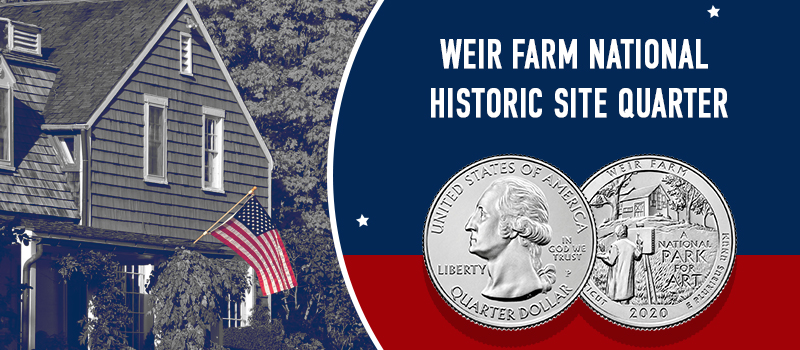Weir Farm National Historic site quarter

“Great Good Place” was how J. Alden Weir described his home, the Weir Farm Historic park at Connecticut. It is a serene and timeless site that is maintained by the National Park Service. It is only one of two National Park sites dedicated to art, the other one being the Saint Gaudens National Historic site. It is set amidst 60 acres of green woods, fields and waterways. The 52nd America the Beautiful quarter released on April 6th by the U.S. mint depicts the Weir Farm Historic park.
J. Alden Weir and the Weir Farm Historic Park
J.A. Weir was an American painter who studied under the likes of the famous French artist Jean-Léon Gérôme in Paris. That’s when he encountered Impressionist art for the first time. Brought up in a classical art household, he couldn’t bring himself to like the completely radical form of Impressionist art. But by the time he came back home to Connecticut, his staunch dislike for the art form had come down. It was at this time that he acquired the 153-acre farmland in Wilton, Connecticut as a fee from the New York art collector, Erwin Davis for a painting he had acquired in Europe.
Weir and his wife Anna Baker Weir established the farm as their home for the next few decades. He started using a new approach to landscape painting with inspiration from Japanese art and the French Impressionist movement. The Weir Farm hosted many notable artists of the time who painted the Ridgefield landscapes; Childe Hassam, Albert Pinkham Ryder, John Singer Sargent, and John Twachtman.
After Weir’s time, the farm was managed by his daughter, Dorothy Weir, also an artist. She lived there with Mahonri Young, the sculptor-painter who established a second studio in the farm. Artist Sperry Andrews, a friend of Young bought the place after Young’s death. His wife Doris Andrews led efforts to preserve the site along with Weir’s third daughter Cora Weir Burlingham. The U.S. government established the Weir Farm as a National Historic park in 1990.
The two studios and the house underwent extensive restoration efforts to make them visitor friendly. Currently there are 16 buildings in the farm along with a hiking trail. The National historic park provides ongoing artist-in-residence programs. The Weir Farm Art Center (formerly the Weir Farm Trust) has hosted more than 150 artists for month long stays at the site.
The Design
The 52nd ATB quarter honoring this National Historic site has a reverse design that shows an artist, wearing a painter’s smock, painting outside J.A. Weir’s studio at Weir Farm. It is inspired by various images of the studio and Weir’s paintings created on the property, as well as descriptions of Weir and his fellow artist’s creative inspiration from the rural environment. It was sculpted by Phebe Hemphill and the designer was Justin Kunz from the Artistic Infusion Program.
This entry was posted in General on April 24, 2020 by lavanya kannan

Leave a comment